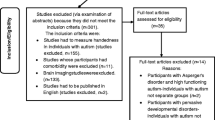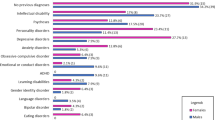Abstract
Reduced corpus callosum area and increased brain volume are two commonly reported findings in autism spectrum disorder (ASD). We investigated these two correlates in ASD and healthy controls using T1-weighted MRI scans from the Autism Brain Imaging Data Exchange (ABIDE). Automated methods were used to segment the corpus callosum and intracranial region. No difference in the corpus callosum area was found between ASD participants and healthy controls (ASD 598.53 ± 109 mm2; control 596.82 ± 102 mm2; p = 0.76). The ASD participants had increased intracranial volume (ASD 1,508,596 ± 170,505 mm3; control 1,482,732 ± 150,873.5 mm3; p = 0.042). No evidence was found for overall ASD differences in the corpus callosum subregions.




Similar content being viewed by others
References
Alexander, A. L., Lee, J. E., Lazar, M., Boudos, R., DuBray, M. B., Oakes, T. R., et al. (2007). Diffusion tensor imaging of the corpus callosum in autism. Neuroimage, 34(1), 61–73.
Amaral, D. G., Schumann, C. M., & Nordahl, C. W. (2008). Neuroanatomy of autism. Trends in Neurosciences, 31(3), 137–145.
Ardekani, B. A. (2013). yuki module of the automatic registration toolbox (ART) for corpus callosum segmentation.
Bertrand, J., Mars, A., Boyle, C., Bove, F., Yeargin-Allsopp, M., & Decoufle, P. (2001). Prevalence of autism in a United States population: The Brick Township, New Jersey, investigation. Pediatrics, 108(5), 1155–1161.
Charman, T., Pickles, A., Simonoff, E., Chandler, S., Loucas, T., & Baird, G. (2011). IQ in children with autism spectrum disorders: Data from the special needs and autism project (SNAP). Psychological Medicine, 41(3), 619–627.
Courchesne, E., Campbell, K., & Solso, S. (2011). Brain growth across the life span in autism: Age-specific changes in anatomical pathology. Brain Research, 1380, 138–145.
Di Martino, A., Yan, C. G., Li, Q., Denio, E., Castellanos, F. X., Alaerts, K., et al. (2013). The autism brain imaging data exchange: Towards a large-scale evaluation of the intrinsic brain architecture in autism. Molecular Psychiatry, 19(6), 659–667.
Egaas, B., Courchesne, E., & Saitoh, O. (1995). Reduced size of corpus callosum in autism. Archives of Neurology, 52(8), 794–801.
Elia, M., Ferri, R., Musumeci, S. A., Panerai, S., Bottitta, M., & Scuderi, C. (2000). Clinical correlates of brain morphometric features of subjects with low-functioning autistic disorder. Journal of Child Neurology, 15(8), 504–508.
Frazier, T. W., & Hardan, A. Y. (2009). A meta-analysis of the corpus callosum in autism. Biological Psychiatry, 66(10), 935–941.
Freitag, C. M., Luders, E., Hulst, H. E., Narr, K. L., Thompson, P. M., Toga, A. W., et al. (2009). Total brain volume and corpus callosum size in medication-naive adolescents and young adults with autism spectrum disorder. Biological Psychiatry, 66(4), 316–319.
Haar, S., Berman, S., Behrmann, M., & Dinstein, I. (2014). Anatomical abnormalities in autism? Cerebral Cortex. doi:10.1093/cercor/bhu242
Herbert, M. R., Ziegler, D. A., Makris, N., Filipek, P. A., Kemper, T. L., Normandin, J. J., et al. (2004). Localization of white matter volume increase in autism and developmental language disorder. Annals of Neurology, 55(4), 530–540.
Hughes, J. R. (2009). Update on autism: A review of 1300 reports published in 2008. Epilepsy & Behavior, 16(4), 569–589.
Jenkinson, M., Bannister, P., Brady, M., & Smith, S. (2002). Improved optimization for the robust and accurate linear registration and motion correction of brain images. Neuroimage, 17(2), 825–841.
Redcay, E., & Courchesne, E. (2005). When is the brain enlarged in autism? A meta-analysis of all brain size reports. Biological Psychiatry, 58(1), 1–9.
Rice, S. A., Bigler, E. D., Cleavinger, H. B., Tate, D. F., Sayer, J., McMahon, W., et al. (2005). Macrocephaly, corpus callosum morphology, and autism. Journal of Child Neurology, 20(1), 34–41.
Robinson, A. (2010). Equivalence: Provides tests and graphics for assessing tests of equivalence. R package version 0.5.6.
Team, R. C. (2013). R: a language and environment for statistical computing. Vienna: R Foundation for Statistical Computing.
Tepest, R., Jacobi, E., Gawronski, A., Krug, B., Moller-Hartmann, W., Lehnhardt, F. G., & Vogeley, K. (2010). Corpus callosum size in adults with high-functioning autism and the relevance of gender. Psychiatry Research, 183(1), 38–43.
Valk, S. L., Di Martino, A., Milham, M. P., & Bernhardt, B. C. (2015). Multicenter mapping of structural network alterations in autism. Human Brain Mapping, 36, 2364–2373.
Witelson, S. F. (1989). Hand and sex differences in the isthmus and genu of the human corpus callosum. A postmortem morphological study. Brain, 112(Pt 3), 799–835.
Yushkevich, P. A., Piven, J., Hazlett, H. C., Smith, R. G., Ho, S., Gee, J. C., & Gerig, G. (2006). User-guided 3D active contour segmentation of anatomical structures: Significantly improved efficiency and reliability. Neuroimage, 31(3), 1116–1128.
Acknowledgments
Supported by Amazon Web Services Education in Research grants.
Author information
Authors and Affiliations
Corresponding author
Electronic supplementary material
Below is the link to the electronic supplementary material.
Rights and permissions
About this article
Cite this article
Kucharsky Hiess, R., Alter, R., Sojoudi, S. et al. Corpus Callosum Area and Brain Volume in Autism Spectrum Disorder: Quantitative Analysis of Structural MRI from the ABIDE Database. J Autism Dev Disord 45, 3107–3114 (2015). https://doi.org/10.1007/s10803-015-2468-8
Published:
Issue Date:
DOI: https://doi.org/10.1007/s10803-015-2468-8




